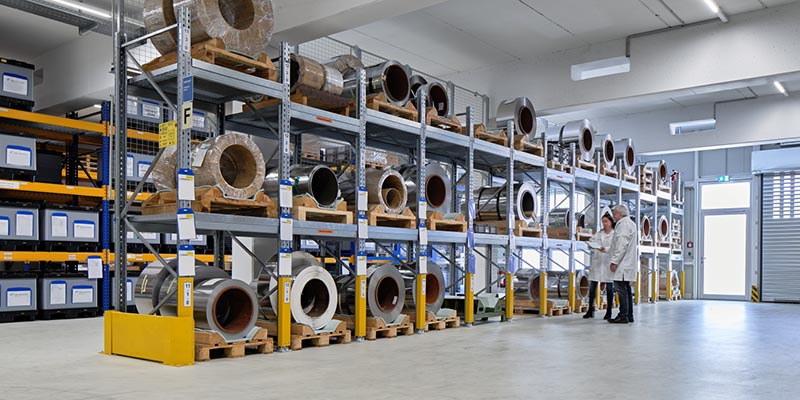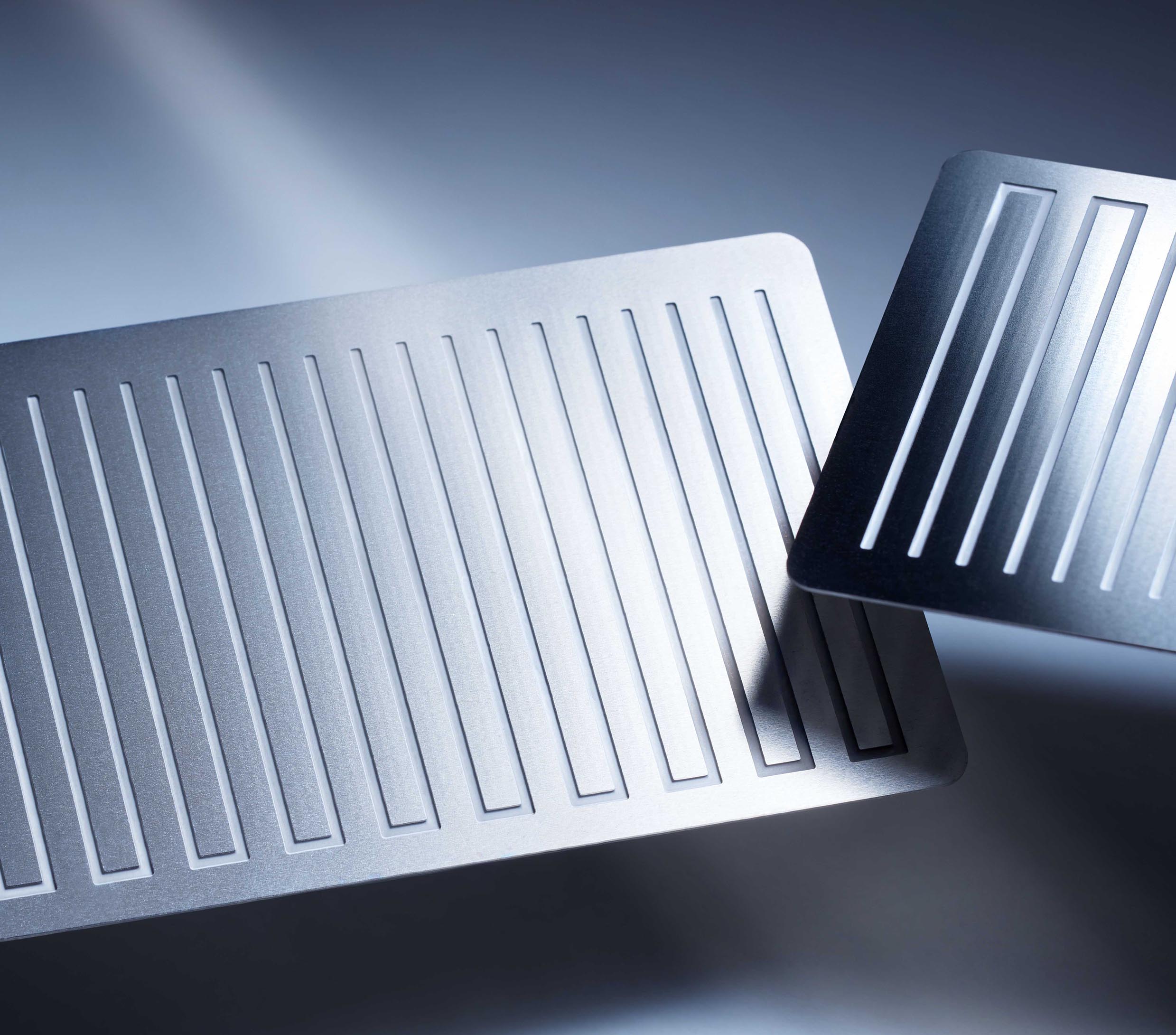
Stainless steel has numerous material advantages for an array of industrial applications, but the chosen processing technology can affect the quality and integrity of parts and components made from this versatile metal.
This article assesses the rationale behind the use of stainless steel for an array of parts and components, and looks at the role of photo-chemical etching as a processing technology that can achieve the production of innovative and highly accurate end-use products.
Why stainless steel?
 Stainless steel is essentially low-carbon steel that contains chromium at 10% or more by weight. Adding chromium gives the steel its unique stainless, corrosion-resisting properties. The chromium content of the steel allows the formation of a tough, adherent, invisible, corrosion-resisting chromium oxide film on the steel surface. If damaged mechanically or chemically, this film is self-healing, provided that oxygen — even in very small amounts — is present.
Stainless steel is essentially low-carbon steel that contains chromium at 10% or more by weight. Adding chromium gives the steel its unique stainless, corrosion-resisting properties. The chromium content of the steel allows the formation of a tough, adherent, invisible, corrosion-resisting chromium oxide film on the steel surface. If damaged mechanically or chemically, this film is self-healing, provided that oxygen — even in very small amounts — is present.
The corrosion resistance and other useful properties of the steel are enhanced by increased chromium content and the addition of other elements such as molybdenum, nickel, and nitrogen.
Stainless steel exhibits numerous benefits. First, the material is corrosion-resistant, chromium being the alloying element that gives stainless steel this quality. Lower alloyed grades resist corrosion in atmospheric and pure water environments; high-alloyed grades can resist corrosion in most acids, alkaline solutions, and chlorine bearing environments making their properties useful in process plants.
Special high chromium and nickel-alloyed grades resist scaling and retain high strength at high temperatures. Stainless steel is used extensively in heat exchangers, super-heaters, boilers, feedwater heaters, valves, and mainstream lines as well as aircraft and aerospace applications.
Cleanliness is also a matter of high importance. The easy cleaning ability of stainless makes it the first choice for strict hygiene conditions, such as hospitals, kitchens, and food processing plants, and the bright easily maintained surface of stainless steel provides a modern and attractive appearance.
Finally, when looking at cost, and considering material and production cost and the life cycle cost, stainless steel is often the least expensive material option, and is also 100% recyclable, thereby completing the full life cycle.
Photo-chemical etching
The micrometal “Etching Group” (comprising HP Etch and Etchform) etches a variety of metals with a precision that is unparalleled anywhere in the world. The thickness of the processed sheets and foils ranges from 0.003 to 2000 µm. Stainless steel, however, remains the number one choice for many of the company’s customers due to its versatility, the numerous grades available, a large number of related alloys, its favorable material properties (as mentioned above), and the vast array of finishes. It is the metal of choice for many applications in a wide range of industries, micrometal specializing in the processing of 1.4310: (AISI 301), 1.4404: (AISI 316L), 1.4301: (AISI 304), and well-known austenitic metals, a variety of ferritic, martensitic (1.4028 Mo/7C27Mo2) or duplex steels, Invar, and Alloy 42.
When compared with traditional sheet metalworking technologies, photo-chemical etching (which produces precision components by selectively removing metal through a photo-resist mask) has several inherent advantages. Most importantly, photo-chemical etching produces parts while at the same time eliminating material degradation, as no heat or force is used during processing. In addition, the process can produce parts of almost limitless complexity as component features are removed simultaneously using etchant chemistries.
The tooling for etching is either digital or glass, so there is no need to start cutting expensive and difficult to adapt steel moulds. This means that large quantities of products can be reproduced with absolutely zero tool wear, ensuring that the first and millionth part produced are the same.
Digital and glass tooling can also be adapted and changed extremely quickly and economically (often within an hour), making it ideally suited to both prototype and high volume production runs. This allows for “risk-free” design optimization without financial penalty. Turnaround time is estimated to be 90% quicker than for stamped parts, stamping also requires substantial upfront investment in mould fabrication.
Meshes, filters, sieves & flexures
The company can etch an array of stainless steel components, including meshes, filters, sieves, flat and flexure springs.
Filters and sieves are required by numerous industrial sectors, and customers often require complexity and the attainment of extremely high precision parameters. micrometal’s photo-chemical etching process is used for the manufacture of an array of filters and sieves for applications in the petrochemical industry, the food industry, the medical sector, and the automotive industry (which uses photo-etched filters due to their high tensile strength in fuel injection systems and hydraulic devices). micrometal developed its photo-chemical etching technology to allow for the exact control of the etching process in 3 dimensions. This facilitates the creation of complex geometries, and when applied to the manufacture of meshes and sieves, dramatically reduced lead times. In addition, special features and various aperture shapes can be included in a single mesh with no increase in costs.
Unlike conventional machining technologies, photo-chemical etching offers greater levels of complexity when producing thin, precision steel meshes, filters, and sieves.
With metal removed simultaneously when etched, multiple aperture geometries can be incorporated without incurring high tool or processing costs, and where punch-perforated sheets are prone to distortion, photo-etched mesh is burr and stress-free with zero material degradation.
The photochemical etching does not alter the surface finish of the material being processed, there being no metal-to-metal contact or heat source used that can alter the surface properties. As such the process can offer a uniquely high-aesthetic finish on stainless steel that makes it appropriate for decorative applications.
Photo-chemically etched stainless steel components are also often used in safety-critical or extreme environment applications — such as ABS braking systems, and fuel injection systems — etched flexures can “flex” millions of times faultlessly as the process does not alter the fatigue strength of the steel. Alternative processing technologies such as machining and wiring often leave small burrs and recast layers which can compromise spring performance.
Photo-chemical etching eliminates potential fracture sites in the material grain, producing flexures free from burrs and recast layers, ensuring a long product life and higher reliability.
Summary
Steel and stainless steels exhibit an array of characteristics that make them ideally suited for numerous pan-industrial applications. While seen as a relatively simple material to process through traditional sheet metalworking technologies, photochemical etching offers manufacturers significant advantages when producing complex and safety-critical components.
Etching requires no hard tooling, allows speedy ramp up from prototype volumes to high volume manufacture, offers almost unlimited part complexity, produces burr- and stress-free components, does not affect metal temper and properties, is appropriate for all grades of steel, and achieves accuracy to ±0.025 mm, all at lead times measured in days, not months.
The versatility of the photochemical etching process makes it a compelling option for the manufacture of stainless steel parts across numerous exacting applications, and stimulates innovation as it removes obstacles for design engineers inherent in traditional sheet metalworking technologies.
Related Glossary Terms
- alloying element
alloying element
Element added to a metal to change its mechanical and/or physical properties.
- alloys
alloys
Substances having metallic properties and being composed of two or more chemical elements of which at least one is a metal.
- burr
burr
Stringy portions of material formed on workpiece edges during machining. Often sharp. Can be removed with hand files, abrasive wheels or belts, wire wheels, abrasive-fiber brushes, waterjet equipment or other methods.
- corrosion resistance
corrosion resistance
Ability of an alloy or material to withstand rust and corrosion. These are properties fostered by nickel and chromium in alloys such as stainless steel.
- fatigue
fatigue
Phenomenon leading to fracture under repeated or fluctuating stresses having a maximum value less than the tensile strength of the material. Fatigue fractures are progressive, beginning as minute cracks that grow under the action of the fluctuating stress.
- fatigue strength
fatigue strength
Maximum stress that can be sustained for a specified number of cycles without failure, the stress being completely reversed within each cycle unless otherwise stated.
- flat ( screw flat)
flat ( screw flat)
Flat surface machined into the shank of a cutting tool for enhanced holding of the tool.
- hard tooling
hard tooling
Tooling made for a specific part. Also called dedicated tooling.
- metalworking
metalworking
Any manufacturing process in which metal is processed or machined such that the workpiece is given a new shape. Broadly defined, the term includes processes such as design and layout, heat-treating, material handling and inspection.
- stainless steels
stainless steels
Stainless steels possess high strength, heat resistance, excellent workability and erosion resistance. Four general classes have been developed to cover a range of mechanical and physical properties for particular applications. The four classes are: the austenitic types of the chromium-nickel-manganese 200 series and the chromium-nickel 300 series; the martensitic types of the chromium, hardenable 400 series; the chromium, nonhardenable 400-series ferritic types; and the precipitation-hardening type of chromium-nickel alloys with additional elements that are hardenable by solution treating and aging.
- tensile strength
tensile strength
In tensile testing, the ratio of maximum load to original cross-sectional area. Also called ultimate strength. Compare with yield strength.
